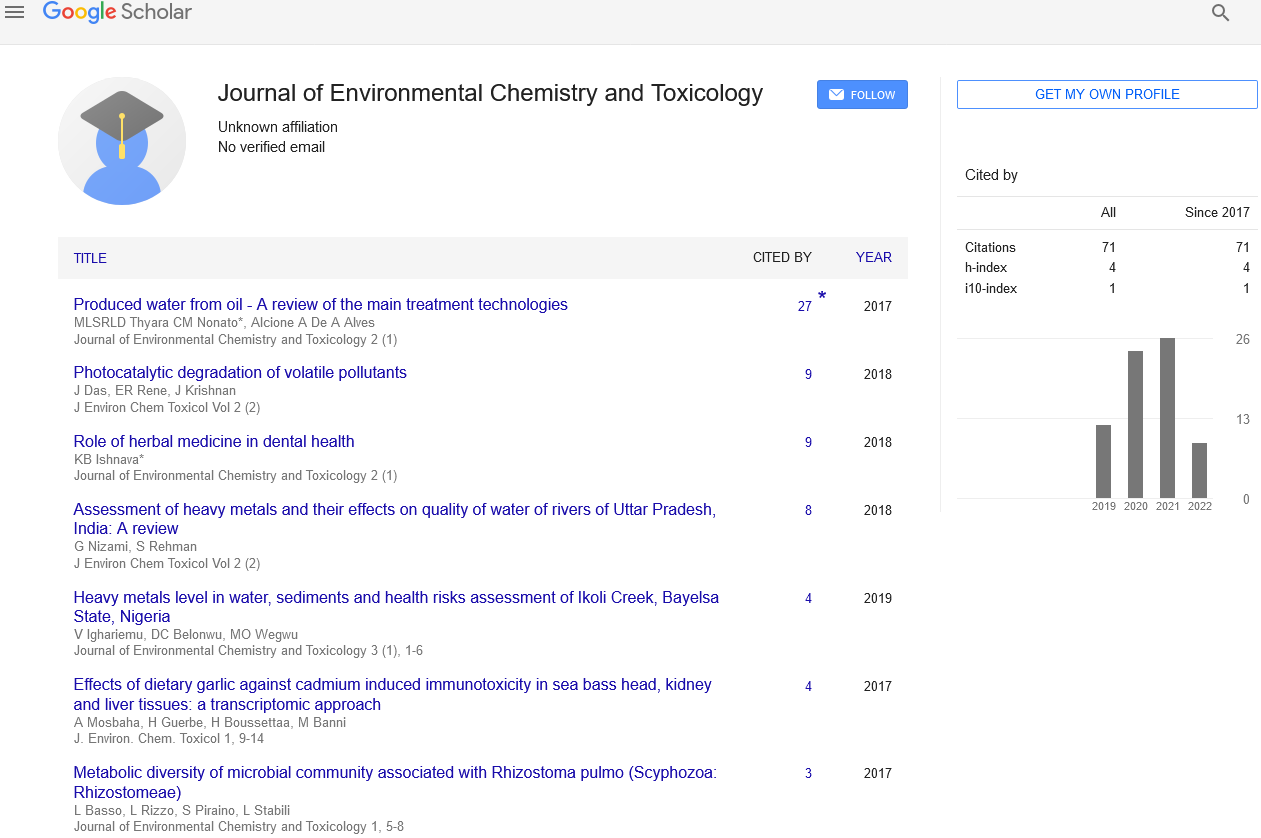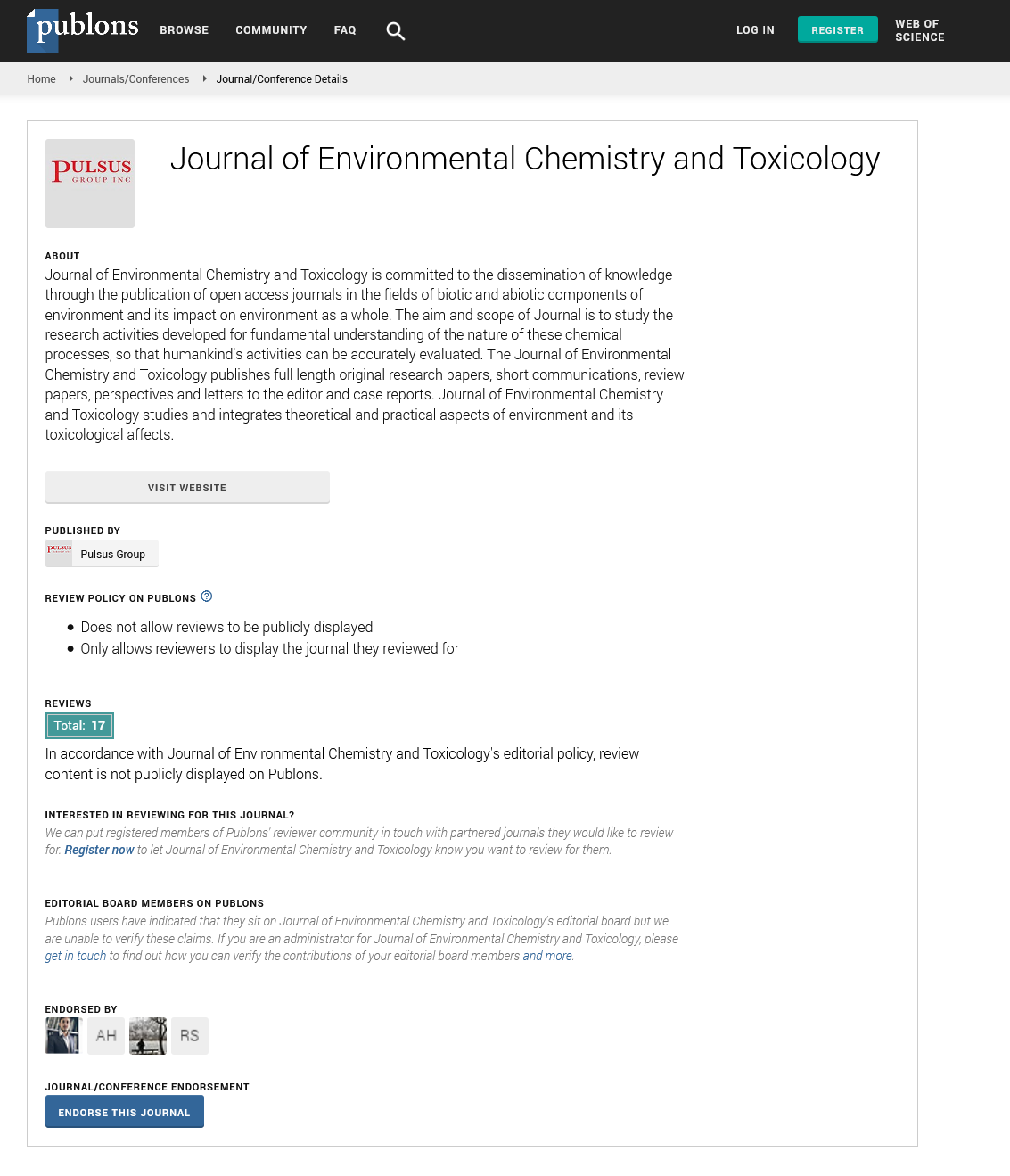Temperature effects on various soil characteristics and plant growth
Received: 04-Mar-2022, Manuscript No. PULJECT-22-4462; Editor assigned: 12-Mar-2022, Pre QC No. PULJECT-22-4462(PQ); Accepted Date: Mar 19, 2022; Reviewed: 14-Mar-2022 QC No. PULJECT-22-4462(PQ); Revised: 16-Mar-2022, Manuscript No. PULJECT-22-4462(R); Published: 24-Mar-2022, DOI: 10.37532/pulject.2022.6(2)-18-19
Citation: Thomson L. Temperature effects on various soil characteristics and plant growth. J Environ Chem Toxicol. 2022;6(2):18-19
This open-access article is distributed under the terms of the Creative Commons Attribution Non-Commercial License (CC BY-NC) (http://creativecommons.org/licenses/by-nc/4.0/), which permits reuse, distribution and reproduction of the article, provided that the original work is properly cited and the reuse is restricted to noncommercial purposes. For commercial reuse, contact reprints@pulsus.com
Abstract
Seasonal and daily variations in soil temperature can be attributed to fluctuations in radiant energy and energy transfer through the soil surface. It regulates physiochemical and biological processes in the soil, as well as inter spheric gas exchange mechanisms between the atmosphere and the soil. The quantity of heat provided to the soil surface and the amount of heat dissipated from the soil surface down the profile are both controlled by environmental conditions. The rate of breakdown and mineralization of various organic compounds is affected by soil temperature. It also has an impact on the amount of water in the soil, as well as its conductivity and availability to plants. The publication established soil temperature as a key factor of the processes that occur in the soil that is required for plant growth.
Keywords
Soil temperature
Introduction
Soil is primary heat storage medium, serving as an energy store during the day and a supplier of heat to the surface at night. During the warm season, the earth stores energy and releases it to the air during the cold season. The ratio of energy absorbed to energy lost from the soil determines the temperature of the soil. It varies both annually and daily, because to changes in air temperature and sun radiation. One of the most essential factors influencing soil qualities and processes involved in plant growth is soil temperature. It regulates the physical, chemical, and biological activities in the soil. It also has an impact on inter spheric gas exchange mechanisms between the atmosphere and the soil. Soil temperature, biological activities such as seed germination, seedling emergence, plant root growth, and nutrient availability are all affected by the quantity of radiation absorbed by the soil. The rate of organic matter breakdown and mineralization of various organic components in the soil is affected by soil temperature. The retention, transport, and availability of soil water to plants are all influenced by soil temperature.
Soil temperature
The temperature of oil is determined by heat flux in the soil and heat exchanges between the soil and the atmosphere. Elias and colleagues it’s also known as the function of the soil’s internal energy. The heat transmission in the soil and the surface latent heat exchanges the principal reasons of fluctuations in soil temperature, solar radiation is the primary source of soil temperature. A thermometer is used to determine the temperature of the soil. Seasonal and daily variations in soil temperature can be attributed to fluctuations in radiant energy and energy transfer through the soil surface.
Temperature of the soil is influenced by a number of factor
The quantity of heat delivered at the soil surface is influenced by a number of parameters, including soil colour, soil texture, and soil moisture. Mulching sun radiation, land surface slope vegetative cover, Organic matter content and evaporation. Color of the soil: Dark soils absorb more radiant heat than light soils. Dark-colored soils, on the other hand, have a greater soil temperature than light-colored soils. Soil mulch: Mulch materials reduce evaporation and increase soil moisture. As a result, the temperature on the soil surface is reduced by these minerals. Mulching the soil’s surface serves to insulate heat, lowering soil temperature. In most cases, less heat will move into a mulched area. Solar energy that reaches the land surface at an angle is spread over a larger area than the same amount of solar radiation that reaches the land surface at straight angles. When a result, as the slope of the land increases, the amountof radiation per unit area of the land surface decreases. As a result, as the slope of the land increases, the temperature of the soil drops. Vegetative cover: Bare earth absorbs heat quickly, becoming hot during the summer and cold during the winter. The temperature of the soil is strongly influenced by vegetation, which functions as a thermal insulator. It prevents the soil from being either too hot or too cold during the dry or wet seasons. Organic matter content: Organic matter improves the soil’s ability to hold water. It also contributes to the soil’s black color. These two soil qualities improve the soil’s heat absorption, resulting in an increase in soil temperature. Evaporation: Water evaporation from the soil necessitates a significant quantity of energy. The energy from solar radiation is used by soil water to evaporate, making it unavailable for soil heating. As a result, the higher the rate of evaporation, the cooler the soil and the lower the temperature. The quantity of heat from the sun that reaches the earth is referred to as solar radiation. The variability of soil temperature is influenced by the amount of solar energy that a soil receives and absorbs. As the amount of solar radiation reaching the soil surface increases, so does the temperature of the soil. Moisture content and bulk density are two parameters that influence the amount of heat radiated from the soil along the profile. Moisture content of the soil: Moisture affects heat dissipation in the soil profile. The flow of heat in a moist soil is greater than in a dry soil with air in the pores. With increasing moisture content, the rate of heat dissipation increases, ochsner and colleagues. Bulk density: A high bulk density raises the soil surface by increasing the rate at which heat energy travels through a unit cross-sectional area of the soil, hence increasing the quantity of heat lost through the soil.
Biological qualities of the soil are affected
Soil respiration is influenced by the activity of extracellular enzymes that breakdown polymeric organic matter in soils at temperatures ranging from 10°C to 28°C. Microbial uptake of soluble substrates is improved and has found that increasing microbial respiration rates increases microbial productivity. Increased microbial activity and organic matter decomposition in the soil boost soil nitrogen mineralization rates. Mineralization is reduced when the soil temperature is below freezing because microbial activity is inhibited and soluble substrate transport is reduced. Oil microorganisms: For their activity, most soil microorganisms require temperatures ranging from 10°C to 35.6°C. Low soil temperatures reduce microbial activity, and near the freezing point, most activities halt Allison. Soil macro-organisms: When soil temperatures range from 10°C to24°C, soil macro-organisms’ rate of metabolism increases, forcing them to either eat more or burn their own fat stores. Conant and colleagues Soil macro-organisms die at extraordinarily high temperatures of 58°C due to the soil’s unfavourable temperature. Temperatures below the freezing point kill soil microorganisms. Soil macro-organisms: When soil temperatures range from 10°C to 24°C, soil macro-organisms’ rate of metabolism increases, forcing them to either eat more or burn their own fat stores. Conant and colleagues Soil macro-organisms die at extraordinarily high temperatures of 58°C due to the soil’s unfavourable temperature. Temperatures below the freezing point kill soil microorganisms. Organic matter decomposition: Due to the sluggish rate of decomposition at temperatures below 0°C, soil matter accumulates. Because microbial activities and biochemical processes slow down at lower temperatures, organic matter decomposes more slowly. 30 By enhancing the mobility of soluble substrates in the soil and activating microbial activity, soil temperatures between 2°C and 38°C promote organic matter decomposition.
Effects on chemical properties of the soil: Capacity for Cation Exchange (CEC)
Increased soil temperature causes organic materials to decompose. As a result of the decrease in organic matter and reduction in clay size clay fraction caused by high temperatures, the soil Certini’s cation exchange capacity decreases. The exchange capacity of the soil decreases as the temperature of the soil rises.
Phosphorus that is readily available
Water-soluble phosphorus rose with soil temperature from 50 to 250 degrees Celsius, due to an increase in phosphorus transport in the soil mediated by diffusion. Phosphorus availability is poor in low-temperature soils because the release of phosphorus from organic material is hampered by low temperatures.
PH of the soil
As a result of organic acid denaturation, which increases at high temperatures, the soil pH rises between 25°C and 39°C.
Structure of the soil
Temperature-induced dehydration of 2:1 clay minerals in the soil occurs as soil temperatures rise, resulting in strong interactions between clay particles, resulting in less clay and more silt-sized particles in the soil. High soil temperatures cause heat-induced fissures in sand-sized particles, which eventually lead to breakdown and, as a result, a reduction in the amount of sand-sized particles in the soil. The clay sand content of the soil decreases as the temperature rises, but the silt content rises. Stability of aggregates The aggregate stability of the soil increases when the temperature rises over 30°C. This is due to the thermal alteration of iron and aluminum oxides, which causes them to function as cementing agents for clay particles, resulting in the production of strong silt-sized particles in the soil.
Moisture content of soil
Increased soil temperatures reduce water viscosity, allowing more water to percolate through the soil profile, resulting in reductions in soil moisture. Furthermore, lower shade paired with higher soil temperatures causes higher evaporation rates, which restricts water transport into the soil profile.
Aeration of soil
The amount of carbon dioxide in the soil air is influenced by high temperaturesthat allows you to attain the bronchiole. Side consequences are every other factor that needs to constantly be taken into consideration, regardless of the applied therapy. Even though STWs are normally wellnormal as a secure healing device because of their low range of aspect consequences, those can nevertheless occur. In a scientific overview and metaevaluation, analyzed all aspect consequences going on with inside the pooled general affected person populace that took component in thirteen medical researches. Focusing on sulfurous waters, after ninety days of STWs remedy, the best 19 out of 370 sufferers supplied a few destructive events. From the ones, thirteen skilled slight nasal irritations and a sensation of burning, five suffered from very restrained epistaxis, and one from dermatological hypersensitivity. Moreover, it’s far of be aware that even if topics supplied the consequences of the one, maximum of them have been nearby and reversible. However, no matter no unusual place uses STWs to acquire a kingdom of wellbeing and ailment amelioration, the cell and molecular bases underlying those useful consequences stay unclear. It changed into lately located that STWs can result in the manufacturing of slight quantities of neutrophilattracting chemokine’s, and occasional stages of tumor necrosis aspect α and Interleukin (IL)-6. Even though pro-inflammatory mediators are regularly related to negative situations, slight inflammatory pressure can appear as positive, consistent with hormesis theory. Thus, slight pressure can stimulate frame structures repair, which allows you to save you similarly and greater extreme damage, supplied that this kingdom does now no longer contain the buildup of irreversible changes. In addition, with time, an infection may also alternate the composition of nasal, sinus, and lung bacterial flora, which can be related to the improvement of resistant lines of bacteria.






